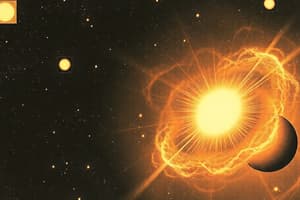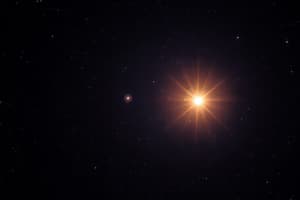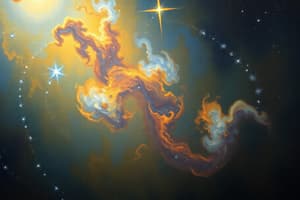Podcast
Questions and Answers
What causes the periodic nova outbursts in T Coronae Borealis?
What causes the periodic nova outbursts in T Coronae Borealis?
- The red giant sheds its outer layers onto the white dwarf. (correct)
- The red giant collides with the white dwarf.
- The white dwarf undergoes a nuclear fusion process.
- The white dwarf absorbs matter from interstellar space.
How often do nova outbursts occur in T Coronae Borealis?
How often do nova outbursts occur in T Coronae Borealis?
- Every 100 years
- Every 200 years
- Every 50 years
- Every 80 years (correct)
What is the expected visibility duration of the nova outburst from T Coronae Borealis?
What is the expected visibility duration of the nova outburst from T Coronae Borealis?
- Up to one month after the explosion
- For several days to slightly more than a week (correct)
- Only during the night of the explosion
- A few minutes after the explosion occurs
What is the distance of T Coronae Borealis from Earth?
What is the distance of T Coronae Borealis from Earth?
When was the last nova outburst of T Coronae Borealis observed?
When was the last nova outburst of T Coronae Borealis observed?
What is essential for a nova event to occur?
What is essential for a nova event to occur?
How is a nova explosion characterized in terms of brightness?
How is a nova explosion characterized in terms of brightness?
What makes the upcoming T Coronae Borealis nova eruption unique compared to typical nova events?
What makes the upcoming T Coronae Borealis nova eruption unique compared to typical nova events?
What happens to the material shed by the red giant in a binary star system?
What happens to the material shed by the red giant in a binary star system?
Which statement accurately describes the stars involved in a nova event?
Which statement accurately describes the stars involved in a nova event?
Flashcards
Cause of T Coronae Borealis nova?
Cause of T Coronae Borealis nova?
Mass transfer from a red giant to a white dwarf
How often does T Coronae Borealis erupt?
How often does T Coronae Borealis erupt?
Approximately every 80 years
Nova visibility duration?
Nova visibility duration?
Several days to a week
Distance of T Coronae Borealis?
Distance of T Coronae Borealis?
Signup and view all the flashcards
Last T Coronae Borealis eruption?
Last T Coronae Borealis eruption?
Signup and view all the flashcards
Essential for a nova?
Essential for a nova?
Signup and view all the flashcards
Nova explosion characteristic?
Nova explosion characteristic?
Signup and view all the flashcards
Unique aspect of this nova?
Unique aspect of this nova?
Signup and view all the flashcards
Where does red giant material go?
Where does red giant material go?
Signup and view all the flashcards
Stars in a nova event?
Stars in a nova event?
Signup and view all the flashcards
Study Notes
Nova Outburst
- A nova occurs in a binary star system with a red giant and white dwarf.
- Material from the red giant accumulates on the white dwarf’s surface.
- This material eventually ignites, resulting in a bright nova explosion.
T Coronae Borealis
- It is a binary star system located about 3,000 light-years away.
- It is known for its recurrent nova outbursts, which happen about every 80 years.
- The last outburst was in 1946.
- The white dwarf star survives each nova event and will continue to have more in the future.
Upcoming Nova Outburst
- NASA predicts that the next nova outburst for T Coronae Borealis will happen before September 2024.
- The exact timing is difficult to predict.
- The nova will be visible to the naked eye for several days, and even longer with binoculars.
- It will appear as a bright star in the Northern sky.
Studying That Suits You
Use AI to generate personalized quizzes and flashcards to suit your learning preferences.





